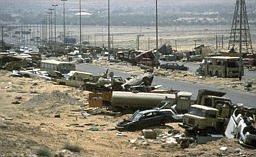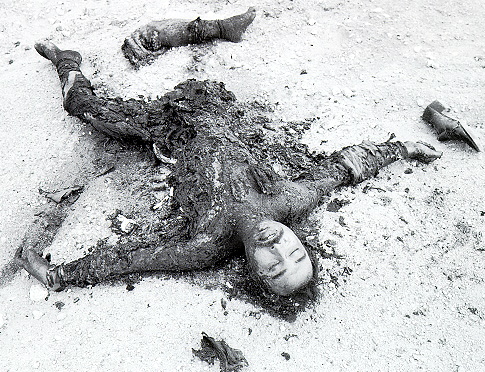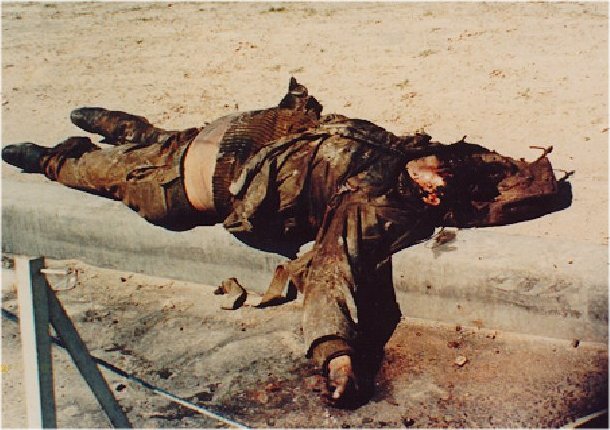The Gulf War
After the invasion of Kuwait events had been set in train that in a few short months would result in several thousand Iraqi dead and millions more casualities, with a devastated land and massive ecological damage, turmoil throughout the Arab world, and financial and political reverbations that would shake the global community. The chronology of the conflict shows an escalading tragedy.
Overall, the coalition air campaign accumulated a total of 109,876 sorties over the 43-day war, an average of 2,555 sorties per day. Of these, over 27,000 targeted Scuds, airfields, air defenses, electrical power, biological and chemical weapons, headquarters, intelligence assets, communications, the Iraqi army, and oil refining. One can get some perspective on the scope of the Gulf air war by comparing it to some predecessors. The following table presents U.S. Army Air Forces, and U. S. Air Force bomb tonnage statistics extracted from various wars, compared with Air Force tonnage dropped in the Gulf War:
War Tonnage Length Tonnage/Month WW II 2,150,000 45 months 47,777.78 Korea 454,000 37 months 12,270.27 Vietnam/SEA 6,162,000 140 months 44,014.29 Gulf War 60,624 1.5 months 40,416.00
During the Gulf War, the United States deliberately conducted bombing aimed at "population will." A report by the General Accounting Office (Cruise Missiles: Proven Capability Should Affect Aircraft and Force Structure Requirements. 04/20/95, GAO/NSIAD-95-116), for example, explicitly states that the Desert Storm air campaign was aimed at "Five basic categories of targets--command and control, industrial production, infrastructure, population will, and fielded forces."
Bombing civilian infrastructure such as electricity, water, sanitation and other things which sustain life was intended, the report says, to "degrade the will of the civilian population."

"Just one comment..clearly I've never been there but this feels like were in the center of hell." - CNN reports on bombing of Baghdad January 16, 1991. |
One of the most significant factors of the Gulf War was the speed with which the US-led coalition was able to achieve air supremacy. Iraqi air defences were systematically devastated, many of the targets being attacked time and time again. Within a matter of days it became clear that Iraqi aircraft were unlikely to engage allied planes and soon, with the speedy and comprehensive destruction of the multilayered Iraqi anti-aircraft systems, allied aircraft were able to range and bomb at will. What this meant in human terms is hard for distant and comfortable observers to imagine. Tens of thousands of hapless Iraqi conscripts, many of them from groups known to be persecuted by Saddam Hussein, had no choice but to sit in the wastes of Iraq and Kuwait until the bombs fell. Here they were forced to suffer napalm, cluster bombs that shred human flesh, the air-fuel explosives (virtual mini atom bombs) that incinerate some and asphyxiate others, and the carpets of 'earthquake' bombs laid down by B-52s - all the obscene paraphernalia that in earlier days had killed perhaps three million people in Korea, Laos, Cambodia and Vietnam.

The Baiji Refinery in northern Baghdad which was hit repeatedly by U.S. aircraft. This clip is from an Iraqi Ministry of Oil video made soon after a Desert Storm bombing attack in 1991. |
The targeting and destruction of Iraq's electricity-generating plants, including four of the
countries five hydro-electric facilities, was little discussed and never questioned during
the war. Pentagon and Bush Administration officials never publically offered a justification
during the war for attacking and crippling most of Iraq's electrical power system -- destruction
which continues to have devestating consequences for the civilian population. As a modern, electricty
dependent country, Iraq was reliant on electrical power for essential services such as water
purification and distribution, sewage removal and treatment, the operation of hospitals and
medical laboratories, and agricultural production.
The report of a UN mission to Iraq in March stated that the allied bombing "has paralysed oil
and electricity sectors almost entirely. Power output and refineries' production is negligible.
The Iraqi government acknowledged in April that the al-Shu'aybah and the al-Nujaybiyah power
plants in Basra had been heavly damaged by allied bombing. The thermal power-generating
plant at Baiji, north of Baghdad, was reportedly the largest in the Middle East' each of the
plant's six units produced 220 megawatts. It was "heavily damaged" during the air war, according
to Iraqi authorities, who announced on April 18 that a team of 500 engineers and technicians
had repaired four the facility's six units.
|
As the Iraqi army was routed in Kuwait and thousands of soldiers tried to escape north, they were bombed by American jets. Iraqi soldiers and the American pilots who targeted them give a first-hand account of what really happened on the road to Basra. This Audio clip is part of a special four-part BBC Radio series to mark the fifth anniversary of the Gulf War, these programs are drawn from the research and reporting done for "THE GULF WAR" BBC/FRONTLINE television series. Each fifteen minute program focuses on an eye-witness account of some of the dramatic events in Desert Storm--the January 1991 military campaign to liberate Kuwait. 'Voices in the Storm' is a Fine Art Production for BBC Radio 5 Live. |

Highway of Death, where thousands of fleeing Iraqi soldiers and civilians were burned alive.
Seymour Hersh, author of Overwhelming Force
speaks about the murder of Iraqi soldiers after the Gulf War cease fire
on Pacifica Radio's Democracy Now, 5/31/00.
|
The relatively brief war saw no first-hand journalistic accounts of the scale of the slaughter: one of the key lessons that Washington had learned from Vietnam was the tactical need to exclude journalists from the scenes of horrors. After the war, accounts appeared in the press, but few of these attempted to depict the numbers of the Iraqi casualties or the enormity of what had been accomplished. At Basra, the journalist Karl Waldron picked his way for 'perhaps 100 yards, trying to count the corpses, but it was a hopeless task. There were not enough whole bodies left to count.' Most of the slaughter was intentional, a matter of military planning; but some of it was accidental, as when the marketplace of Fallujah was bombed. Abdullah, the grandson of Terfeh Mehsan, is - we are told - a 'handsome but frail boy of 12... Where his legs used to be, Abdullah has two little stumps, the skin flayed with septic cuts.' Some of the accounts describe the destruction of the convoys desperately attempting to flee from Kuwait; as, for example, on the doomed road to Umm Qasr: '60 miles of carnage... scores of soldiers lie in and around the vehicles, mangled and bloated in the drifting desert sands.'
 Two Iraqi Corpses on a mangeled truck
(Click to Enlarge)
Two Iraqi Corpses on a mangeled truck
(Click to Enlarge)
|
 Two Iraqi Corpses on a mangeled truck
(Click to Enlarge)
Two Iraqi Corpses on a mangeled truck
(Click to Enlarge)
|

A Charred Iraqi soldier. |
At one spot, snarling wild dogs have reduced two corpses to bare ribs. Giant canion birds claw and pick at another; only a boot-clad foot and eyeless skull are recognisable.
One fiat-bed track has nine bodies. Each man clutches the next. Their hair and clothes are burned off, skin incinerated by heat so intense it melted the windscreen on to the dashboard.
Another body hangs from the driver's seat of a shrapnel-riddled frontend loader. Half a corpse sits in a mack with twisted metal for an engine. Blowing sand laps at other bodies on the roadside
Such reports soon stimulated discussion as to what might constitute a war crime. Thus the correspondent Denis Knight (The Guardian, 5 March 1991) suggested that the deliberate massacre of thousands of fleeing soldiers might qualify. And what of the specific weapons used? Paul Flynn, British Member of Parliament, cites a report that fuel air explosives were 'designed to produce nuclear-like levels of destruction without arousing popular revulsion'; and comments (The Guardian, 21 June 1991 ) that the 'cluster bombs, daisy cutters and fuel air explosives should not be classed as conventional weapons... They are massacre weapons.' He adds that the British government has willfully refused to recognise 'the holocaust results of the Gulf War. The most recent estimate is that 100,000 to 200,000 Iraqis were killed and 300,000 to 700,000 injured. Most of them Shia and Kurdish conscripts.'
 An incinerated Iraqi Soldier
An incinerated Iraqi Soldier
(Click to Enlarge) |
In no estimates are there fewer than tens of thousands of Iraqi casualties. The journalist Christopher Bellamy, after some preliminary computations, suggests that this 'still leaves a huge number [of lraqi soldiers] missing' (possibly approaching 200,000). British estimates, cited soon after the end of the war, suggest at least 90,000 Iraqi soldiers killed; with a French military expert estimating as many as 150,000 Iraqi fatalities. When Beth Osborne Daponte, a demographer at the US Census Bureau, published her own estimates of 158,000 Iraqis, half of them women and children, killed in the war and its aftermath, efforts were made to fire her. Her boss, Barbara Torrey, accused Daponte of using 'false information' and of 'untrustworthiness and unreliability'. Lawyers from the American Civil Liberties Union (ACLU) then threatened legal action, whereupon Daponte was reinstated. She later commented: 'They wanted to suppress the figures because I had broken them down to show how many women and children had died... I find it extremely disturbing that the US Census Bureau tried to suppress and delay the release of information that is embarrassing to the current administration. Government employees should not be fired for speaking the truth . . . in this case the figures were clearly politically embarrassing.'

A destroyed Iraqi tank |
Ken Livingstone, British MP, pointed out (The Independent, 11 March 1991) that most of the 'vast slaughter' took place when the Iraqi government had already declared its willingness to withdraw from Kuwait and when in any case the Iraqi army was in a state of disintegration. And Marjorie Thompson, Chair of CND and the Committee to Stop War in the Gulf, commented in letters to The Independent (6 March 1991) and The Guardian (7 March 1991) that the slaughter of the fleeing Iraqis was an unforgivable act that will come to rate alongside Dresden and Hiroshima 'as one of those acts no one in the world will be found to justify'. In one report Robert J. Lifton, Professor of Psychiatry and Psychology at the City University of New York, and director of the Centre on Violence and Human Survival, quoted a taxi-driver who had summed up 'accurately enough' the character of the one-sided conflict: 'This ain't no war. It's just us dropping bombs and killing people.' Here it is suggested that much of the slaughter could have been avoided if the war had been ended earlier, as the Soviet Union and other states had urged, while still achieving the goals laid down by the United Nations; and perhaps the war itself could have been avoided altogether 'by pressing sanctions and a diplomacy of common security'
 A slaughtered Iraqi Soldier
A slaughtered Iraqi Soldier
(Click to Enlarge) |
Further reports indicated the extent to which the war had been fought against human beings, rather than simply against tanks and other weaponry. Thus some discussion was provoked by the revelation that the American army had used earthmovers and ploughs mounted on tanks to bury thousands of Iraqi soldiers alive. One attack of this sort resulted in thousands of Iraqi dead and wounded, with not a single American fatality. Colonel Lon Maggart, commander of the US 1 st Brigade, estimated that his forces had buried about 650 Iraqi soldiers; and Colonel Anthony Moreno, commander of the 2nd Brigade, commented: 'For all I know, we could have killed thousands… What you saw was a bunch of buried trenches with people’s arms and things sticking out of them’. Such improvised mass graves, to which must be added the bulldozing of thousands of Iraqi corpses at the end of the war, are part of the post-war face of Iraq and Kuwait. And there are many other characteristic features in the erstwhile battlefields: not least the massive detritus of beaten armed forces, the inevitable residue of unexploded ordnance, and the radioactive waste left in the desert by the allied forces.
It can be assumed that many of the Iraqi casualties were caused by
inaccurate bombing: the US forces, while at first lauding the reliability of the 'smart'
weapons, later came to admit the massive number of inaccurate targetings. Thus in one
classified US analysis, the computer-navigated Tomahawk cruise missiles hit their targets
just over 50 per cent of the time. The 'smart' laser-guided bombs launched from the US
F-117A Stealth attack jets hit their targets in only about 60 per cent of the missions
flown, in contrast to the 90 per cent claimed earlier. In any case, of the 88,500 tons
of bombs dropped on Iraq and Kuwait, only 6520 tons were precision-guided, and 70 per cent
of the total 'missed their targets', according to a defence expert quoted by The
Washington Post.

The Highway of Death - A virtual mass grave |
At the end of the war, wrecked armaments, unexploded mines and other munitions, radioactive debris and mass graves littered the Iraqi and Kuwaiti deserts. It was also suspected, though not at that time known for certain, that the American forces had drawn up plans for the contingency of launching chemical and nuclear attacks against Iraq. Thus Major Johan Persson, a liaison officer at a Swedish army field hospital, declared in interviews in Stockholm that he had seen official guidelines about the use of nuclear and chemical weapons in certain circumstances. Declared Major Persson: 'There was such an order. I saw it. I had it in my hand. It was the real thing.' When US Secretary of State James Baker met the Iraqi foreign minister Tariq Aziz on 9 January 1991, days before the start of the US-led bombing of Iraq, Baker declared: 'We know that you have a vast stock of chemical weapons... Our sincere advice to you is not to even think of using them. If you do, or if we feel that you did, then our reply will be unrestrained. I hope I am understood well.' The authoritative commentator Mohamed Heikal noted Aziz's understanding 'that Baker was hinting at the use of nuclear weapons'.
It was also known that the infrastructure of the Iraqi state had been comprehensively devastated, though detailed reports had yet to emerge. At the end of the war the toll of US casualties was small; to the hundreds of thousands of Iraqi dead, wounded and traumatised, tens of thousands more casualties were to be added.